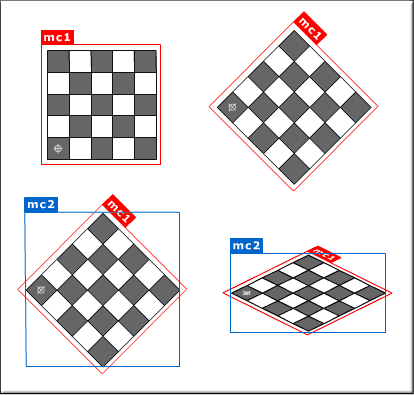|
 Different
Approach Towards Isometric Positioning
Different
Approach Towards Isometric Positioning
by senocular
Flash, being as special as it is,
allows us to take a completely different approach to handling isometric
positioning without the need of any kind of complicated calculation as
previously mentioned. This is achieved through movie clip transformations.
Because movie clips are self-contained and operate through their own timeline
and own coordinate space, you have the ability to change and alter the
appearance of a movie clip. on the screen and not effect any of the movie clips
internal proportions. Visually, on the screen they appear altered, but this is
only because, as a viewer, you are seeing them as through a transformed
instance.
Lets say for example, if you were to
take a movie clip, and reduce its height by 50%, the contents of that movie clip
would visually shorten from the main timeline. Though, from within that movie
clip, one would not see/display any signs of change. This is because the
contents themselves were not altered, but rather the clip they are in.
If you haven't already caught on, the point I'm getting at is that, instead of
using mathematic calculations to position objects isometrically, we can let
Flash do it for us using movie clips to automatically add the needed
transformations, then globalize the new point to the main timeline and position
objects there to the newly acquired point.
There's two calculations needed here, one being the rotation, as we are going
from a square grid to a rotated diamond like grid, and then a scaling
transformation to give us that perspective look and bring us closer to the
30/26.6 degrees of isometry. This is done with two movie clips - one for each
transformation.
See illustration:

(The gray cross hairs represent
(0,0)) For any movie clip. within mc1, given a normal path along say, the _x
axis, that movie clip. would, on the screen, appear to traveling along the
isometric angle from within those transformations. The only problem is, it too
would be rotated and scaled and distorted beyond normal recognition. That is
where the globalization comes into play using Flash's localToGlobal() function
where you'd use either an a simple variable point or even an empty movie clip to
maintain your grid position and relay that to the main timeline as a coordinate
there.
For example, in a similar set up as
before with the ball (_root.ball) and the grid, only the grid is transformed
like described and the following code is placed on an empty clip in
_root.mc1.mc2 representing the grid movement:
Transforming the point with
localToGlobal() allows the ball in _root placed on that position to follow this
clip precisely without any complicated calculations. All positioning within
_root.mc1.mc2 (the grid) relates accordingly to the apparent isometric position
when viewed from the main timeline.
Now this technique can pretty much replace that which uses the functions
outlined earlier, however, the _y if you'll notice is flipped here as it is in
Flash (which isn't a big deal) and this method as a whole is a little unorthodox
and possibly even confusing due to its transformations. Those transformations
also require going through the scope of 2 movie clips to obtain any of your
desired points which in itself may be obnoxious to deal with.
Using the mathematical approach over
this one is more practical and contained. It may be a little more difficult to
understand but it presents itself to be the easiest to handle as everything is
operated through one scope, plus it allows the methods used to be more easily
ported to another language. The rest of isometric handling discussed here will
be through that method.
|